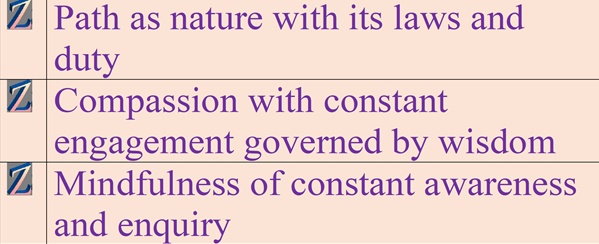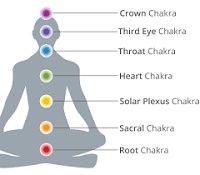15) Embodying Love-Wisdom Balance

For zandtaomed the final step of MwB is embodying a love-wisdom balance leading to the clear vision of tathata. Recognition of this final step has come from studies in the Prajna portal, sadly it has not arisen solely from the studies of Buddhadasa’s MwB. What is important about this chapter is that in our practices we give equal weight to love and wisdom; whilst this equal weight is not reflected in the level of contents of the Companion (which has a wisdom bias), seekers need to focus on equal weight of love and wisdom in their practice as decsribed in this chapter.
As a meditation elder zandtaomed is concerned with helping seekers develop practice. As far as he understands it this practice that will eventually lead to autonomy – for zandtaomed his own autonomy shows itself in zandtao’s prajna portal. For zandtaomed his advice is concerned with the development of a practice that will lead to the seeker’s autonomy, and then this practice becomes the backbone for the seeker’s journey into their unknown. If a seeker wishes to see how zandtao became aware of this omission of emphasis on love and embodiment, then they can go to the portal and examine the books Real Love and Secular path?. But for seekers developing a practice the issues raised in the portal are sound but can raise doubts; for such seekers it is not necessary to engage at this stage with the doubts but it is necessary to develop a practice. Once a seeker feels they are driven by autonomy they might choose to investigate what zandtao has done in the portal as part of their own journey into the unknown.
In terms of developing practice a seeker needs to know that cultivating and embodying love is an integral part of good practice. In terms of MwB this first arises in the second tetrad, and how we use love to control the vedanas; cultivating love to control the vedanas is different from Buddhadasa’s practice in MwB of calming the vedanas. Love goes beyond calm because of its power. Not attaching to feelings that arise through vedana is important but the power of feelings is important and calm does not use that power. When we feel love we are using vedana’s power.
Zandtao introduces the feeling of love at the final stage of the 2nd tetrad. In the first 3 stages various techniques are used so that we don’t attach to new vedana as well as not attaching to old vedana. But we then channel the power of vedana through love. Nicola Amadora in her feminine way uses a Divine Mother meditation to feel the love of the Divine Mother – Mother Earth; zandtao uses this love of the Divine Mother in stage 4 of the 2nd tetrad. Before moving onto the 3rd tetrad zandtao asks us to feel love, and then in the 3rd tetrad this love can be built through the brahma-viharas before the work of releasing attachments and regaining consciousness that happens during the remainder of the 3rd tetrad. When we talk of the Dhamma comrades it is considered that they arise through MwB meditation, love however needs to be cultivated – rather than an arising. Zandtao recommends cultivating the love of the Divine Mother in the final stage of the 2nd tetrad, but seekers can cultivate love however they feel.
During the 3rd tetrad we try to gain wisdom through the releasing of attachment – through the arising of the Dhamma comrade wisdom. The problem of MwB is not the gaining of wisdom, but the emphasis towards wisdom that does not include enough love. Once we enter integrating in the 4th tetrad we look to develop the love-wisdom balance and use it. Prior to the 16th stage that starts with having faith in the path – abiding in the path, zandtao advises that we do a love-wisdom embodiment.
For this love-wisdom embodiment zandtao uses an approach that is adapted from Jac O’Keeffe’s embodiment meditation. Jac starts with bringing kindness into the heart, but zandtaomed has already brought in the feeling of love as the culmination of the 2nd tetrad. The next stage of this embodiment is to create the space in the body for later integration. Jac does this by creating spaciousness throughout the parts of the body in turn. Zandtao wants to create similar spaciousness but there is already love throughout because of the 2nd tetrad and there is space from having released attachments in the 3rd tetrad; in the 4th tetrad Zandtao has also tried to develop a state of atammayata after the 3 characteristics of Buddhism – anatta, anicca and quenching dukkha, so this process of spaciousness at stage 15 is a kind of final sweep where space is created by releasing any attachments that have sneaked through.
Through this love-wisdom MwB there is now spaciousness that is free from attachment, and zandtao wants to fill this space with love-wisdom; he uses a chakra meditation to do this. Here are the chakras zandtao is going to use:-

If you have followed the Seeker Story or have done the exercise of “chakras by the bootstraps” in the Pathtivism Manual, use what you have previously worked with. To be perfectly honest so long as you don’t resist the possibility of chakras it does not matter how you use the chakra process. Jac used 3 chakras, others describe chakras differently – these choices do not matter. We are going to build up a chakra ridgepole of love-wisdom and that is all that matters for this embodiment.
So we start with the root chakra and bring in love from the Divine Mother and wisdom from source consciousness. We breathe in love, we breathe in wisdom and we try to develop a feeling of love and a knowing of wisdom in the root chakra. We do the same for the next 5 chakras until we use the crown chakra for building the chakra ridgepole. In the crown chakra we develop a feeling of love and a knowing of wisdom, and then we build the ridgepole. We join all the feelings of love and knowings of wisdom together in one chakra ridgepole of love-wisdom. We feel a solid core of a love-wisdom ridgepole up and down the body’s core. Once we can feel the strength of this ridgepole we can move onto the two stages of integration.
So we now feel a chakra ridgepole of love-wisdom, and we are going to fill our spaciousness with love-wisdom. We expand that ridgepole into the spaciousness of the whole body so that our whole body feels the balance of love wisdom. We want to feel that integrated balance throughout our whole bodies. It is an integrated feeling – not just love in the heart and wisdom in the head but an embodiment of love-wisdom throughout our whole bodies. This is a whole body integrated feeling of love-wisdom.
Once we are comfortable in this integrated feeling of love-wisdom we are going to integrate our feeling of love-wisdom with Unity and interbeing. So we have expanded our love-wisdom from the chakra ridgepole to our whole being and from there we are going to expand and integrate our love-wisdom with Unity. There is just a Unity of love-wisdom, and that is the end of stage 15.
That leaves us with the culmination of our love-wisdom meditation – tathata – in stage 16. In ch14 we spoke of having faith in the path that then led to abiding in the path. At stage 16 our faith in the path has united any consciousness that we have released from our attachments, reconnected with source-consciousness and we are abiding in our paths. Now we are going to use our love-wisdom to develop tathata. Abiding in our paths we bring the love-wisdom into our awareness and just focus. With this focus we are using our love-wisdom to see, just see, feeling and knowing we see the way things are – tathata. One we bring together our seer-consciousness through love-wisdom seeing happens and we develop tathata – feeling, knowing and seeing the way things are.
Through embodying our love-wisdom balance we develop our seer-consciousness of tathata. There is a tathata from wisdom but a more complete seeing comes when we embody a love-wisdom balance.
Companion Summary
Undoubtedly if you look at the approach in Part 1 of the Companion you can clearly see a wisdom bias. It is important to understand why I continued with the Companion as it is – rather than rewriting the Companion with a love-wisdom balance.
Firstly I have moved on from writing about developing practice as with zandtaomed, zandtao felt no desire for this level of writing perfectionism. Secondly the amendments I have made plus the addition of the second part could well be enough. For any seeker there is a need to have a love-wisdom balance in their practice – an equal weight of love and wisdom.
But throughout the first part there are many spiritual developments – admittedly biassed towards wisdom. But if you examine the contents of the Companion there are many processes that can be used for love as well as wisdom. As an example consider ch3 on complete engagement. The purpose of focussing on this process is so that the seeker focuses their spiritual development in daily life, in the chapter it was concerned with wisdom but it can equally be applied to love. So as part of the Companion work there should now be complete engagement with love in daily life ie embodiment. We could write similar about other processes – consolidation of love, deep acceptance of a love-wisdom balance, sampajanna – love-wisdom-in-action – embodiment of love-wisdom as opposed to just embodiment of wisdom, and so on. Apart from using the first part to develop wisdom, the processes of the first part could still be used with love.
How would we use the Companion? Ideally an elder would guide a new seeker through this meditation process, but that might not be possible. Firstly there is the meditation infrastructure of MwB, a seeker might choose to consider a blank 4x4 grid/table. Then the seeker could read the wisdom of Mindfulness with Breathing, and complete the grid initially. Then the seeker could look at the Companion and recognise processes for the development of wisdom that zandtao advised about. Then the seeker could seek a love-wisdom balance within their own practice ensuring there is equal weight of love and wisdom, that there is a practice of love-wisdom embodiment in which love and wisdom are given equal weight. This unbalanced process is not ideal but a seeker should note that this imbalance arises in many religions – not just Buddhism or Buddhadasa, a religious approach in which there is emphasis on wisdom and not enough emphasis on love. For zandtaomed the advice is work with an elder who understands the importance of a love-wisdom balance.
Next Ch16 For pathtivists/Companion Contents/Previous Ch4 Teaching Methodology
|





